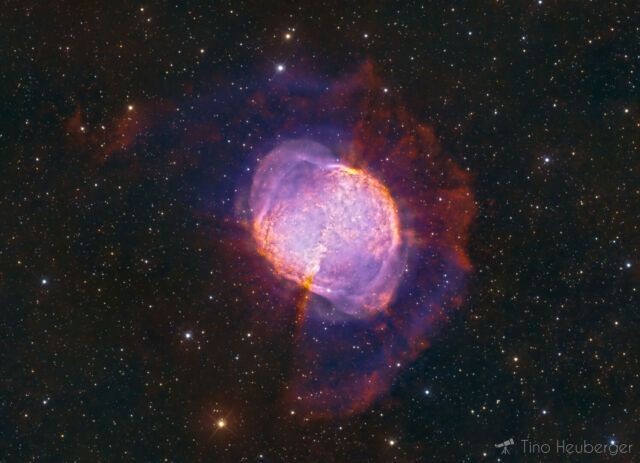
This is a reprocess of some of my data from last year from Messier 27 using new techniques and skills. Especially the core of got a lot more details, and the stars turned out a lot lot better. The Dumbbell nebula is a bright planetary nebula located in the direction of the Vulpecula constellation around 1360 light years from earth. At its center lays a dying star, which has been ejecting a shell of hot gas into space for approximately 48'000 years. In my narrowband photo, hydrogen gas is colored red, oxygen gas blue and sulfur green. The star responsible for the nebula, is a very hot, blueish subdwarf star, emitting highly energetic radiation mostly in the non visible part of the light spectrum. The radiated energy is being absorbed by the surrounding gas, which causes the gases to ionize and glow in a very specific color (hence why narrowband filters can be used to make certain chemical elements visible). The blueish tint in its center is due to the large amounts of oxygen present there. It appears there are hydrogen jets coming out from the left over dwarf star (visible as red “jets” coming out from the center). The nebula itself is made up of different shock-wave fronts, which can easily be seen as different “shells” travelling through the nebula. These are expanding at a rate of up to 40-80km/s! Note that this is a Narrowband image, meaning there were 3 filters used that only let one narrow spectral line through, producing 3 black / white images which were then assigned to RGB channels. Because of this, one can see from the colors, where which chemical element is present. Red is Hydrogen, Blue is Oxygen and Green / Orange is Sulfur. The first two images are the new edit, and the last one the old (with the exact same data). 20h 10min of total exposure time Taken with: Losmandy G11 QHY163m RC8" #astrophotography #space #astronomy #astrodon #photoghraphy #photog #longexposure #nightsky #science
theuberger
For comparison, this is how the old version looked like (100% the exact same data)